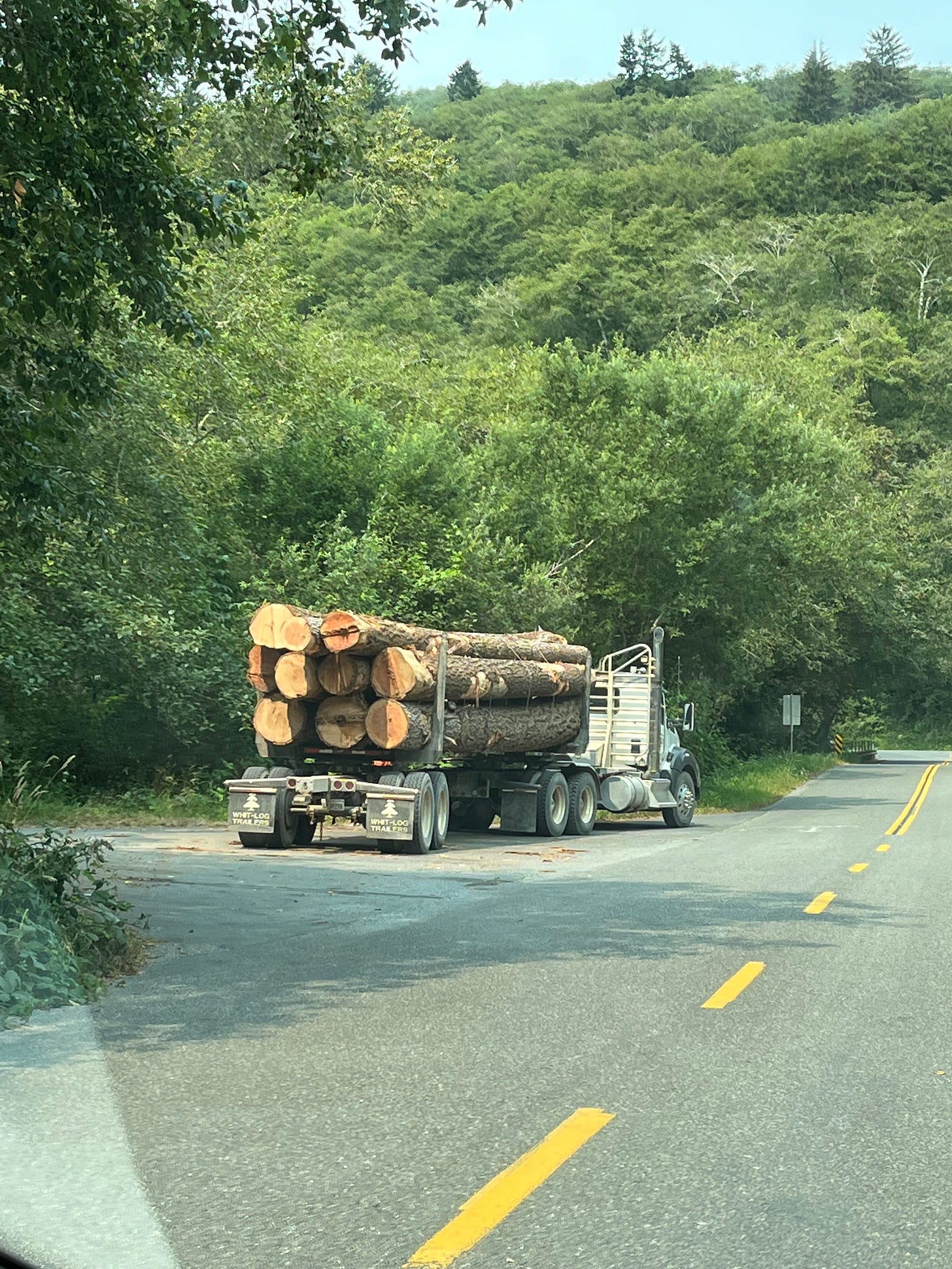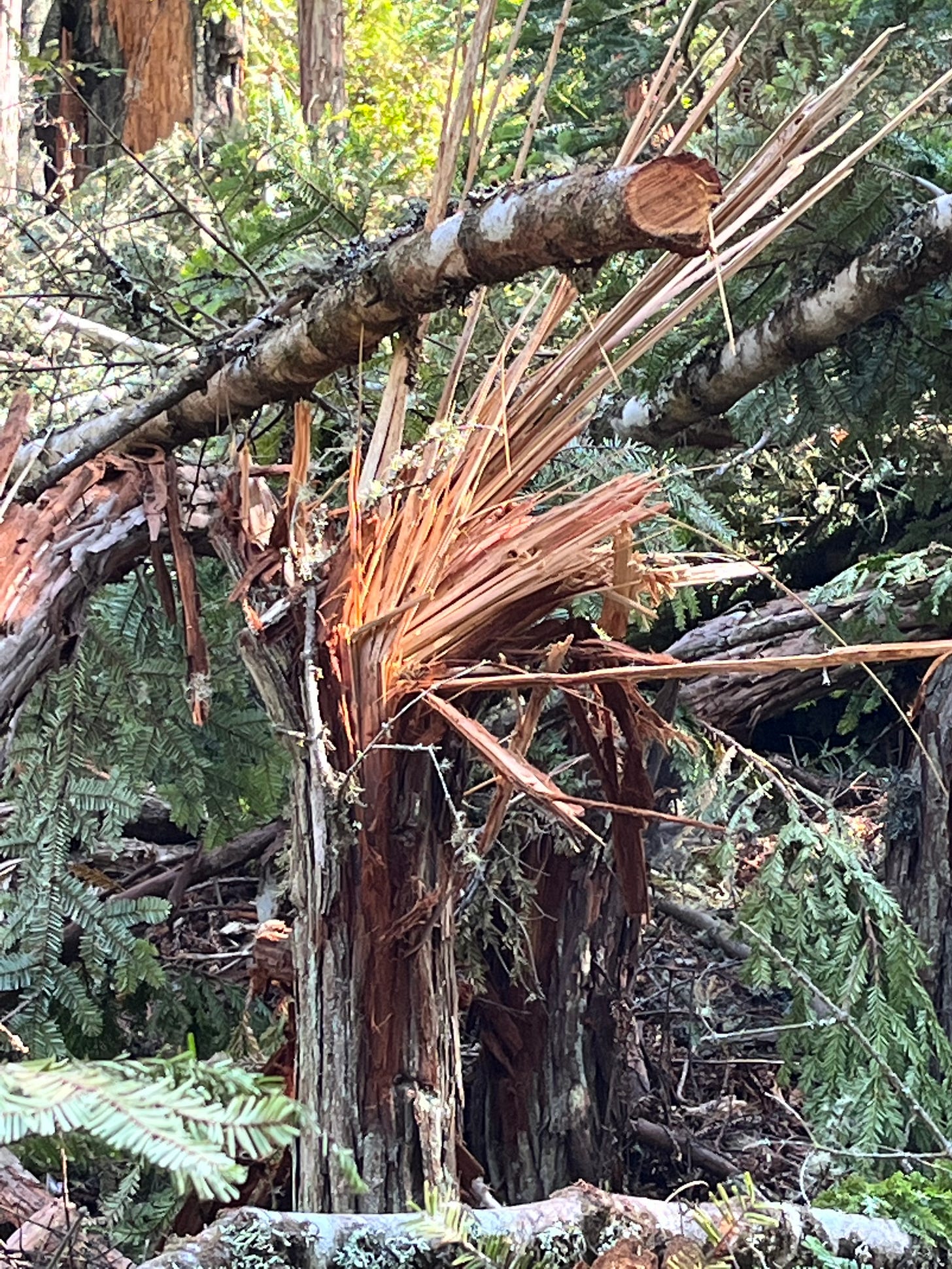Logging trees during a rising need for forests
A local redwood logging project disturbs the quiet—and why these forests deserve better.
You’re at Mother E, a free newsletter exploring our connections to nature and other species in a climate-changing world. If you missed the last edition, it’s here: The Art of Thanksgiving
If this newsletter gets shortened by an email program or the images don’t show, you can read it on the website here. To get Mother E coming to your email box every other Sunday, sign up below.
SOMETIMES ONE HAS TO BEAR WITNESS when a situation seems impossible to stop.
So, I found myself sitting on a stump in the forest this month, listening to the buzz of chainsaws on the large parcel next to the one I monitor in Point Arena, CA. The saws sounded like angry hornets and were accompanied by the thwack, thwack of axes and other tools. Piercing backup beeps sounded as vehicles maneuvered around felled trees. Loud, clanking equipment stripped off the branches and some bark and loaded what was left onto long logging trucks.
The end result is trucks piled with skinned trees barreling down the coastal highway towards the lumber mill, trailing surrender “flags” of shredded bark and lichen.
This logging on private land owned by a timber company is targeting coastal redwoods and Douglas firs. These trees may end up as decking for homes, picket fences at Home Depot, or lesser products.
The logging company had previously published notice of this sizable timber harvest plan (THP) to cut 895 acres of mostly redwood forest. The plan was cheekily called “Seventh Heaven” presumably due to the anticipated profits.
A half dozen of us wrote letters protesting this plan, asking for additional studies on the negative impacts of habitat loss, wildlife disturbance, and nearby river disruption. In addition, these trees are lost as natural removers of CO2 (a warming greenhouse gas) during a worsening climate crisis.
The sad fact is that ultimately, this timber harvest plan and most others locally are approved by the CalFire agency for cutting.
As I listened to the tree-cutting noise, a red-tailed hawk flew from the logging area, calling stridently. Perhaps it was protesting the disturbance to its hunting grounds and interruption of its daily life.
Boom, I hear another tree fall to the earth; its life ended. Some smaller trees don't make much noise if they land on thick duff, but the larger ones don't go down quietly. There's often a sharp crack of wood breaking as the last part of the trunk splinters. Minutes of more chainsawing pass, then another crack and boom follow— an additional tree down.
I set the stopwatch on my phone to see how many they cut in a period. Three trees cut down in ten minutes—that's eighteen trees an hour at that rate. Since they will cut thousands of trees, it will take months to complete this large timber harvest.
We think of logging as necessary, but cutting mature redwoods seems unwarranted in our climate crises. These trees can live for 2000 years or longer, each one taking tons of CO2 out of the air and storing it in its woody body for many centuries.
Redwoods and other large-growing trees are needed allies in the fight to steer the climate toward a safer zone. Why are we cutting down our living allies?
Is it because private property rights currently override the benefit to the broader population? If so, our challenge is to find a better balance so that a few corporations can't control the fate of large tracts of forest that give us oxygen and bring rain to benefit the region.
In addition to the rights of the commons (all of us), there's the issue of the forest dwellers' rights.
Does the shy and endangered Point Arena Mountain Beaver enjoy the right to an intact forest and undisturbed creek flow?
Does the osprey have rights to the tall tree where it builds its nest (called an eyrie)?
Does the Orange Fritillary butterfly have rights to its food source— a spring and summer meadow full of native blooms?
Does the coastal redwood have the right to live out its natural long life span?
These species have enjoyed the right to live in this place for many thousands of years. Is it fair that recent human laws and practices override them?
Shifting baselines may make it hard to see the losses we've inflicted on other species over time. Historical accounts of steelhead and salmon in my local Gualala River in the 1800s tell of a river "flashing" with thousands of large fish during the spawning season. One firsthand account tells of the reluctance of horses to cross the river due to the many large fish churning through the water. Today, the rarity of salmon (a keystone species) has negatively affected the entire Gualala watershed.
We live in a world that's been intentionally and incidentally wounded. To make it through this growing peril of losses, it's necessary to start honoring the rights of all species to exist.
Indigenous scientist Robin Wall Kimmerer adds another dimension— that of returning the joy the world still offers us.
Even a wounded world is feeding us. Even a wounded world holds us, giving us moments of wonder and joy. I choose joy over despair. Not because I have my head in the sand, but because joy is what the earth gives me daily and I must return the gift.
Robin Wall Kimmerer, Ethnobotanist and author of Braiding Sweetgrass
My heart aches for the thousands of redwoods being cut down here this month, for the loss of habitat that follows, and the forest ground crushed by bulldozers and piled with logging slash. But as those emotions and thoughts flow through, the noisy sawing takes a break, and some quiet returns.
What emerges out of this new silence is the faint, high-pitched peeps of small birds foraging and the whisper of a breeze through the canopy. The sun is warm on my back, and I notice patches of tiny parachute-shaped mushrooms growing under the conifers. Life, it seems, is persistent and hopeful even with destruction nearby.
In contrast to this logging, redwood forest conservation is starting in other areas of Mendocino County. In 2022, Save the Redwoods League has protected several thousand more acres from commercial logging.
The League’s emphasis is both visionary and pragmatic, adding and connecting acreage to popular parks and giving more forests the chance to become stately “old growth.” In addition, they are raising funds to put conservation easements on properties to promote light touch, sustainable forestry. The future requires a restorative approach to our forests for the sake of all species. 🌲🦌🦅
Robin Applegarth
A band that sings birds? Meet Dakha Brakha.
An ethnic musical group from Kiev, Ukraine that brings the sounds of local birds and insects into their music. Enjoy!
I like to hear from readers!
You can comment at the button above, respond to this email to reach me privately, or reach out on Twitter @RobinApplegarth.
Thank you for reading Mother E and for your involvement in making the world a better place!
Not subscribed yet? Mother E is a free newsletter about our connections to other species in a climate-changing world. Sign up below to have it delivered to your email box every other Sunday.





I've been reading Suzanne Simard's "Finding The Mother Tree," which I recommend as required reading for everyone. Unsafe and harmful logging no longer belongs in this world.
Robin,
Here's an Op-Ed in today's Daily Montanan addressing the issues I wrote to you about yesterday.
https://dailymontanan.com/2022/12/05/nothing-will-be-left-of-forests-after-forest-service-gets-done-restoring-them/?eType=EmailBlastContent&eId=84154d86-016a-44ca-ba84-4db8e73845ab